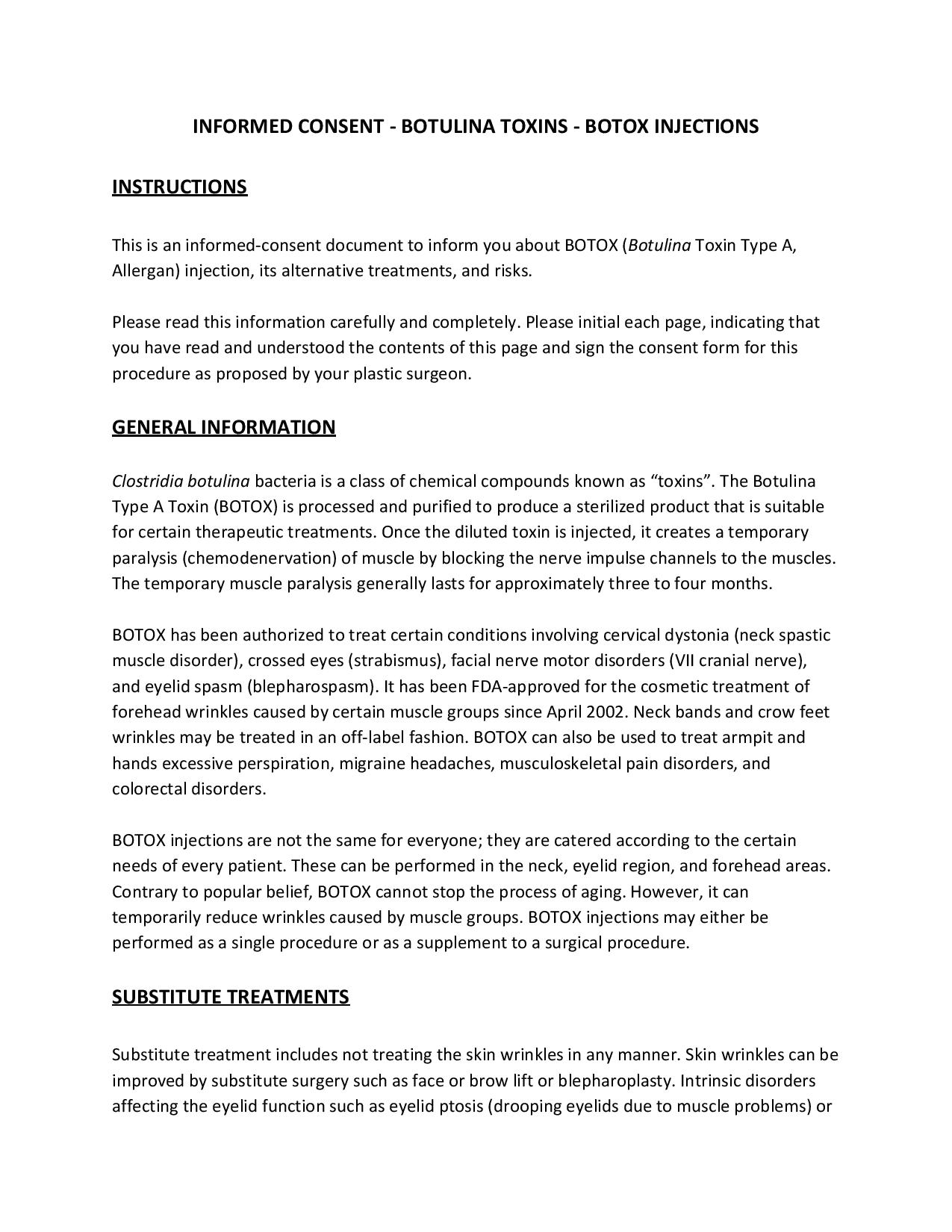- Eviction Notice Forms
- Power of Attorney Forms Forms
- Bill of Sale (Purchase Agreement) Forms
- Lease Agreement Forms
- Rental Application Forms
- Living Will Forms Forms
- Recommendation Letters Forms
- Resignation Letters Forms
- Release of Liability Agreement Forms
- Promissory Note Forms
- LLC Operating Agreement Forms
- Deed of Sale Forms
- Consent Form Forms
- Support Affidavit Forms
- Paternity Affidavit Forms
- Marital Affidavit Forms
- Financial Affidavit Forms
- Residential Affidavit Forms
- Affidavit of Identity Forms
- Affidavit of Title Forms
- Employment Affidavit Forms
- Affidavit of Loss Forms
- Gift Affidavit Forms
- Small Estate Affidavit Forms
- Service Affidavit Forms
- Heirship Affidavit Forms
- Survivorship Affidavit Forms
- Desistance Affidavit Forms
- Discrepancy Affidavit Forms
- Career Assessment - 16+ Examples, Format, Tips, Pdf Forms
- Undertaking Affidavit Forms
- General Affidavit Forms
- Affidavit of Death Forms
Botox Consent Form
The number of cosmetic or aesthetic procedures done has gone up over the years due to the majority of women seeking eternal youth and picture-perfect facial features. In 2017, the botulinum toxin type A or Botox injections ranked first among the top five cosmetic minimally invasive procedures. But before a plastic surgeon gets their hands on you, you have to be informed about its basics through a botox consent form. This consent form variant gives you all the important information you need to know prior to the procedure. From then on, you can decide whether to carry on or back out of the procedure. Read More
Botox Consent Form
- Can a patient be represented by someone when signing a botox consent form?
- Am I required to ask for informed consent all the time?
- What happens if I failed to ask for fully informed consent?
- What is the difference between consent and informed consent?
- Can a patient refuse to give their informed consent?
What Is a Botox Consent Form?
A Botox consent form is an informed consent form that is used to inform the patient of the general information, procedure, possible risks, complications, side effects, alternative treatments, and financial requirements of the procedure. The consent form gives the plastic surgeon or medical provider the green signal to carry on with the treatment. This form is also legally binding.
How to Create a Botox Consent Form
In 2017 alone, there were about 7.23 million Botox procedures done; that’s a 2-percent increase from 2016. The figures show no signs of decreasing, and it is expected that more individuals will go to you and get this procedure. Create an informed consent for your patients with these helpful tips:
1. Include a General Information About Botox
Your patients might have probably researched the background of Botox, but they will understand it better if the information comes from a licensed professional. Include general information about Botox so they would get an in-depth understanding of what they about to undergo. This includes its function and procedure and at the same time, it should also debunk the belief that it stops the process of aging.
2. List the Possible Risks and Complications and Alternative Treatments
Like any other medical procedure, Botox has its own set of possible risks and complications. This is disclosed so that patients would be mentally prepared and would know what to expect after the procedure. These are extremely helpful especially to patients with underlying conditions because it might have adverse effects on their health.
If your patient decides to seek another treatment as a substitute to Botox, inform them about face or brow lift and blepharoplasty. If they want specific treatment for eyelids and minor skin wrinkles, then provide them with the alternative treatments for these also. Don’t fail to inform them that these alternatives are not free of risks and complications.
3. Discuss Health Insurance
Most health insurance companies do not provide coverage for cosmetic procedures and their complications simply because they are medically unnecessary. Instruct your patients to review their health insurance policies before proceeding.
4. Highlight Financial Responsibilities
The Botox procedure might not always end up as one expected. Risks and complications, although unusual or rare, might occur unexpectedly, and the patient may be forced to dish out additional money to cover the costs. Aside from these, revision or optimization may be needed to achieve the desired outcome. Furthermore, professional fees and follow-up visits should also be shouldered by the patient.
5. Add a Consent Form For the Patient to Sign
This form mainly consists of the things that the patient has to agree with, including being informed about the procedure, the apparatuses to be used, the surgeon’s limitations, being photographed or televised as part of the documentation, and the risks and complications. Once they agree to these, they are free to sign the form.
Frequently Asked Questions
Can a patient be represented by someone when signing a botox consent form?
Yes. A patient can be represented by someone if they are under the legal age, if they want someone else to make medical decisions for them (they should acquire an advance directive first), and if they can’t give consent (suffering from advanced Alzheimer’s disease).
Am I required to ask for informed consent all the time?
No. In case of emergencies, your healthcare provider may turn to your closest relatives to ask for consent. But if you are in a life-threatening situation, your healthcare provider may no longer need to ask for consent; instead, they may proceed with the procedure with the sole intent of saving your life.
What happens if I failed to ask for fully informed consent?
If you failed to ask for informed consent from your patient, then you may be sued for medical malpractice. According to Cates Mahoney, the procedure can get really harmful if the healthcare provider fails to provide the following:
- Proposed treatment or procedure alternatives
- Reasonably foreseeable risks and benefits of not proceeding with the proposed treatment or procedure
- Proposed treatment or procedure’s nature
- Reasonably foreseeable risks and benefits of said alternatives
- Foreseeable risks and benefits of the proposed treatment or procedure
What is the difference between consent and informed consent?
The former is self-explanatory while the latter is an educated and informed decision. The latter is commonly used in the medical field wherein the patient is informed beforehand of the nature, risks and complications, alternatives to the procedure. The patient can then decide whether it is beneficial or harmful to them.
Can a patient refuse to give their informed consent?
Yes. According to Crico, a patient may not give their informed consent, and you should not attempt to get it because legally, it can be considered as a form of battery.
Healthcare providers vow to protect and improve the wellbeing of their patients. That is the very core of their profession. No matter what the specialty, no patient should be subject to unwanted side effects due to lack of information—this is where informed consent comes in. Informed consent informs the patient of the lesser-known facts, risks, complications, side effects that may give the patient plenty of time to decide if they want to proceed or not. This will lessen the alarm that comes post-operation and indemnifies the surgeon if these said risks occur. Be transparent with your patients by providing a botox consent form first before any treatment or procedure.

